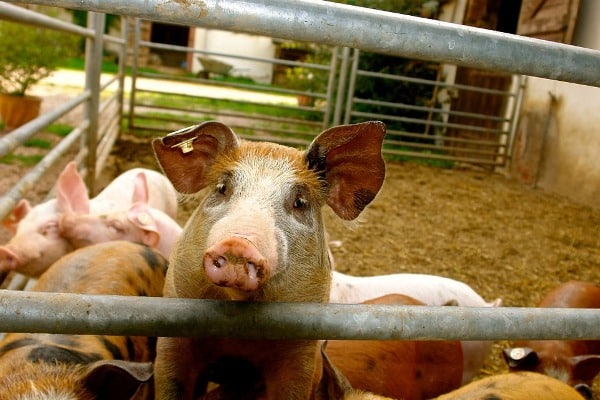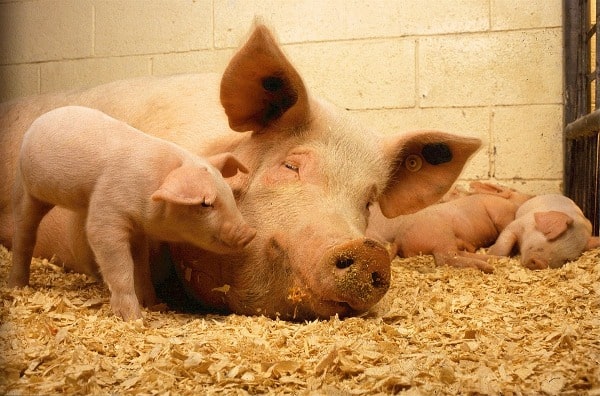Pig fattening techniques, ideas, and tips
Today, we discuss the topic of pig fattening guide.
The Pig fattening has an intensive diet to maximize its growth at the best cost, in respect of the environment. The feed is, normally formulated on the basis of the average requirements of the batch (depending on the average weight of the group, its genetic type and the distribution organism of the farm) and the costs of the cereals. The diet can then be badly adapted to the individual need and causes an imbalance of the flora, which can cause developmental disturbances and heterogeneity in the batch. What to feed pigs to fatten them up? Whatever you choose, 50% of feed should be yellow corn. The remainder of your pig’s feed must be a mix of barley, wheat, and sorghum. Feed your pig various grains and observe which it likes best. Use the pig’s favorite grain in abundance in order to increase pig weight.
Feeding pigs in the fattening phase depends mostly on two factors:
- Farm type (backyard, standard or high performing)
- Age & weight of the pig
Housing for Pig fattening

This is determined by the class of the pig. Permanent pig houses must be cool, durable and easy to clean. The floor must be made of concrete, while roofing could be made of corrugated iron sheets covered with bamboo leaves, grass or Adex. The free-range system could be used for the fattening, but the range will need to partition with fencing materials into paddocks of suitable sizes. The farrowing pen is designed to have the sow and the piglet. With less restriction and occurrence of guard rails (open pens) or in a confined space immediately before, and after farrowing. A pregnant or dry sow can be kept in pens designed to accommodate 3 to 5 animals (3 m x 2 m). An open pen with feeder running from the wall, so that individual sows have stalled and feeding area and a common passage should suffice.
The boar pen is of related design to accommodate a boar and a sow at mating. Fattening pens should be such as to minimize loss of feed resulting from spillage and contamination. A typical fattening pen must be big enough to accommodate 8–12 pigs of the same age and weight. Pens 8m x 4 m with feeder running from wall to wall.
Important pig fattening considerations in balancing rations:
Crude fiber: An important part and one that frequently receives little consideration in balancing rations for fattening pigs is crude fiber. This comprises the woody part of the feeding stuff and consists mainly of cellulose, which is much less digestible than other constituents of the feed. It is a very high content of crude fiber that makes a ration bulky.
Protein: The protein question is always very important in pig feeding as nearly all the common grains are deficient in protein. Some of the cereal by-products have enough protein, but not of the proper quality. It becomes essential, therefore, to supply this lack with some feed that contains a high percentage of protein and in which the protein is the proper kind. Such feeds are tankage, the oil meals, skim milk, and buttermilk and within certain limit alfalfa. The pig seems to need animal or legume protein, but when once the protein requirements of the animal are met it is of no advantage to adding more; in fact, it could be a disadvantage. The highest values often obtained from tankage or skim milk is not to be obtained when these feeds are given in larger quantities than enough to furnish the required protein. The optimum quantity of digestible animal or legume protein for a fattening pig is about one-fourth pound a day.
Minerals: Our definite information on the value of minerals for hogs or pigs is limited. It is known, however, that the hog must be given some minerals to supplement the grain rations since the grains are deficient, particularly in calcium, or lime.
Water: The pig needs excellent clean water accessible at all times. Water in the feed and water in the trough are the same to the pig supply there is not too much in the feed so that he has to consume too much water in order to obtain enough feed. It seems that the entire ration for a fattening pig must not contain more than 60 percent water and that if it does contain more than 60 percent the pigs will not consume enough feed and will create slower gains and take on less finish.
Vitamins: Pigs that are running outside and are on green pasture will obtain plenty of vitamins, but pigs that are shut inside are very apt to endure from lack of vitamins. The vitamins likely to be lacking in a pig’s ration are the fat-soluble vitamins A and D. Both these vitamins are abundant in cod-liver oil. Vitamin A is abundant in butterfat. These oils and fats are not economical sources of vitamins for pigs or hogs. Alfalfa meal is about the best supply of vitamins for pigs in dry lot. A small quantity daily of some green crop such as kale can be used to advantage by the pigs in dry lot.
Nutrition:
The feed is the biggest cost factor in pig production and can amount to 60 – 80 % of the total cost of production. Correctly fed pigs or hogs will ensure:
- Efficient reproduction and growth
- Efficient feed utilization
- Good-quality meat
- Maximum profit for the farmer.
Read: Pig Farming Loan, Subsidy in India.
Pig fattening recommendations

- Open the feeders up during the last 7 to 10 days in the nursery, so the pigs optimize feed intake before moving. When they arrive on the grow-finish floor, they will have an expanded gut, an excellent healthy appetite, and be ready to eat.
- The diet the last 7 to 10 days in the nursery and the diet the first 7-10 days on the grow-finish floor must be as similar as possible with respect to composition although the nutrient density can differ slightly. This decreases the chance for a feed intake interruption or instability in the gut microflora as a result of feed refusal.
- Monitor and manage ingredient feature to encourage feed intake. Pay particular interest in the quality of any supplemental fat or high-fat feed ingredients as well as feeding high-quality grains free of mycotoxins.
- Strategically use organic acids with a high degree of antimicrobial activity during the water lines as the pig’s transition from the nursery to the grow-finish floor.
- Use of the acids will help stabilize gut microflora and help avoid potential threats from pathogenic bacteria. Where the management of diarrhea in the fattening stage is a concern, utilize an appropriate level of dietary organic acids in the feed to help keep a consistent, gut microflora.
- In addition to organic acids, use of supplemental copper (Cu) through the pre-fattening and fattening period, particularly as a highly obtainable source such as chelated copper, may help promote growth and rapid feed intake. Cu has traditionally been considered to be required in the gut for its effect. However, research with chelated Cu suggests that this could only partially be true and that providing a highly presented source of Cu may be preferred for performance and environmental reasons.
- Optimize digestibility of ingredients, minimizing the number of fermentable carbohydrates and proteins in the gut during the use of phytase and non-phytase enzymes. Optimizing diet digestibility serves to both optimize feed intake and nutrient utilization (efficiency), helping to drive growth and lean meat produced per unit of feed consumed. Optimizing diet digestibility helps deprive potential pathogenic bacteria of nutrients for their growth.
- Use either a mash diet with slightly higher particle size or feed a pellet with a low percentage of fines the first 2 weeks on the grow-finish floor to minimize the risk of gastric ulcers through the time when feed intake may be interrupted.
Read: Sheep Fattening Business Plan.
Feed sources
Grains
- Grain constitutes a range between 55 and 70 % of the total feed mixture.
- While grain is mostly an energy source with low protein content, it contributes substantially (30 to 60 %) to the protein content of the mixture.
- Grain sorghum has a nutritional value related to that of maize. Provided sweet sorghum (low tannin) varieties are used, sorghum could be substituted for maize on an equal basis in feed mixtures.
Oil-cake meals
Soya-bean oil-cake meal and sunflower oil cake meal are plant protein feedstuffs generally included in pig feed mixtures. Soybean oil-cake is of a higher and improved quality protein and contains considerably less fiber than sunflower oil cake.
Full-fat oilseeds
Full-fat soya-bean and sunflower seed meals have high oil content. The resulting oil in soft fat in pig carcasses.
Hence, the inclusion of these two feedstuffs, if fed in combination with maize, should be limited in rations for finishing pigs. Full-fat soya-beans should be heat treated before use to destroy a substance (trypsin inhibitor) which reduces the growth rate of pigs.
Fishmeal
Fish meal is the most frequently used and best protein source to contain in feed mixtures.
Calcium and phosphorus sources
Feed lime is a very good calcium source and is not very expensive, but it contains no phosphate. Monocalcium phosphate, dicalcium phosphate, and bone meal are generally included as sources of phosphate. These sources contain calcium, but in smaller quantities than feed lime.
Read: Winter Gardening Care, Techniques.
Good day!, As a newbie on pig farming..I want to ask these ff questions..1.HOW DO WE CHOOSE GOOD FATTENER (HOG)2.HOW DO WE CHOOSE A GOOD BREED FOR SOW?..That’s All and thank you in advance for the answers..